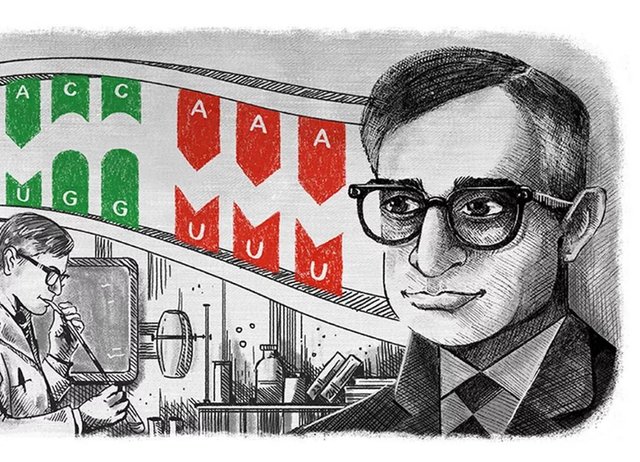Har Gobind Khorana deciphered DNA and wrote the dictionary for our genetic language
Tuesday’s Google Doodle honors the pioneering biochemist and Nobel Laureate.

Our understanding of how genes shape us owes much to the work of Har Gobind Khorana, the Indian-American biochemist celebrated in Tuesday’s Google Doodle on what would have been Khorana’s 96th birthday.
Khorana, depicted in the doodle by Bangalore-based illustrator Rohan Dahotre, shared the 1968 Nobel Prize in physiology/medicine with Robert Holley and Marshall Nirenberg “for their interpretation of the genetic code and its function in protein synthesis.”
Working independently of each other, the researchers mapped out what’s now the central dogma of biology — that information is stored in DNA, a genetic instruction manual, and then transcribed into RNA, which in turn is translated into the language of proteins.
The world-renowned scientist’s illustrious career blossomed from humble roots. Uncertain of his own birthdate (he guessed it was January 9), Khorana was the fifth child born to a Hindu family in 1922 in Raipur, a 100-person village in the Punjab region of what is now Pakistan.
He started his education at a village school that met under a tree and quickly demonstrated an aptitude for science, tempered with humility. He received a scholarship to study chemistry at Punjab University in Lahore, but he was too shy to attend the mandatory admissions interview and considered majoring in English instead.
The admissions committee was still impressed enough with Khorana’s application that they enrolled him anyway. He went on to earn undergraduate and master’s degrees in chemistry at Punjab University, followed by a doctorate in organic chemistry at the University of Liverpool in England.
His friend Uttam L. RajBhandary, a molecular biology professor at the Massachusetts Institute of Technology, said Khorana was drawn to solving tough, critical problems. “He was not influenced by its difficulty or the time needed to solve it, as long as it was of fundamental importance,” RajBhandary wrote.
Khorana did stints in research institutions in Switzerland and Canada before landing at the Institute for Enzyme Research and the University of Wisconsin, Madison. There, he decoded how cells read the language of RNA written in structures represented by the letters A, C, U, and G. He did this by using enzymes to create sequences of these letters. Arranging them into distinct patterns, he and other scientists found that the genetic code comprised 64 three-letter “words,” known as codons.
The words code instructions for arranging amino acids, the basic units of proteins. The sequence “GGT” codes the amino acid glycine, for example, while the “UAA” codon tells cellular machinery to stop adding to a nascent protein.
Put together, the findings yielded something of a Rosetta Stone for genetics, bridging the divide between molecular instructions and the machinery they build.